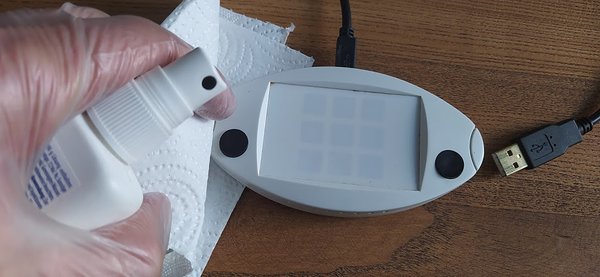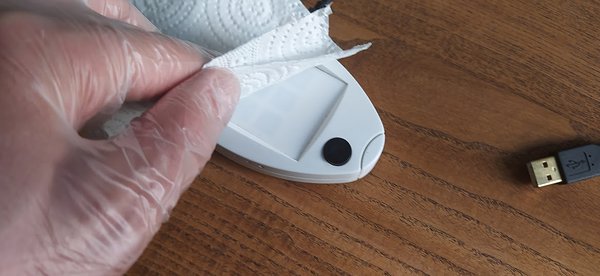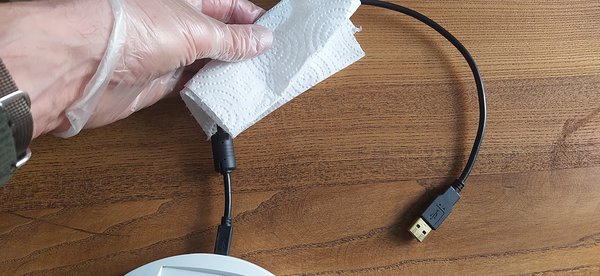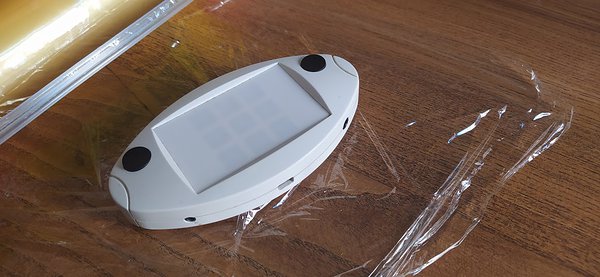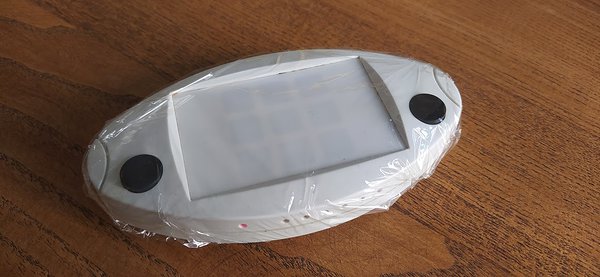Disinfecting QIKtest Device
Aus aktuellem Anlass ist es besonders wichtig, das QIKtest Gerät nach jedem Gebrauch zu desinfizieren. Das Virus kann bis zu drei Tagen auf Kunststoff/Plastik nachgewiesen werden (1) (2). Das Gehäuse des QIKtest ist aus Kunststoff. Bitte folgen Sie diese Anleitung zur gründlichen Desinfektion.
Bilder anklicken für Vergrößerung
Benötigte Materialien:
- Desinfektionslösung oder Spray
- Papiertücher, Einweg/Einmalgebrauch, Küchenkrepp
oder Einmal-Desinfektionstücher - Handschuhe: Vinyl oder Latex
Reinigung/Desinfizierung des QIKtest Geräts
Wie oft? Nach jedem Gebrauch/Test.
Wischen Sie jede Fläche und das Kabel des QIKtest Geräts ab. Handschuhe verwenden.
Vorsicht, bitte nicht das Gerät direkt besprühen, oder direkt Desinfektionsflüssigkeit darauf geben, vor allem nicht in Gehäuseöffnungen wie Knöpfe, Anzeige, Anschlußbuchsen - wischen!
Danach Arbeitsfläche reinigen, oder Papierhandtuch vorher darunterlegen.
Nach der Reinigung Handschuhe und Papierhandtücher entsorgen.
Frischhaltefolie Methode für QIKtest-Gerät
Laden Sie zuerst die Testdaten vom PC auf das QIKtest Gerät mit dem USB-Kabel.
Wickeln Sie dann das QIKtest in Frischhaltefolie, ca 20x20cm je nach Haftkraft der verwendeten Folie.
Reichen Sie das eingewickelte Gerät an den Patienten/Klienten, Test durchführen.
Entfernen Sie die Folie nach jeder Nutzung unter Verwendung von Handschuhen.
Knüllen Sie die berührte Seite der Folie in Richtung nach innen; zusammen mit Handschuhen entsorgen.
Tipp: auf der englischsprachigen Seite finden Sie zusätzlich Hinweise zur Reinigung Ihrer Praxis.
Sie werden viele Einweghandschuhe benötigen.
Bleiben Sie gesund!
=========================================
References Ahttps://www.nejm.org/doi/full/10.1056/NEJMc2004973
Aerosol and Surface Stability of SARS-CoV-2 as Compared with SARS-CoV-1
March 17, 2020DOI: 10.1056/NEJMc2004973
Figure 1. Viability of SARS-CoV-1 and SARS-CoV-2 in Aerosols and on Various Surfaces.
===================================
References B(1)
https://medicalxpress.com/news/2020-03-coronavirus-days-plastic-complicated.html
When the scientists placed virus-laden droplets on plastic, they found that half of the virus was gone after about seven hours. Half of what remained was gone after another seven hours, and so on. By the end of Day Two, there was less than 1/100 of the original amount, and after three days the remnants were barely detectable.
(2)
N van Doremalen, et al. Aerosol and surface stability of HCoV-19 (SARS-CoV-2) compared to SARS-CoV-1. The New England Journal of Medicine. DOI: 10.1056/NEJMc2004973 (2020).
https://www.sciencedaily.com/releases/2020/03/200317150116.htm
https://www.nih.gov/news-events/news-releases/new-coronavirus-stable-hours-surfaces
...
The study was coauthored by scientists at the National Institutes of Health, the Centers of Disease Control and Prevention, UCLA and Princeton University. It was made available in print form on Monday, and aims to provide more clarity on the virus’s contagiousness.
...
The scientists found that SARS-CoV-2, the virus that causes COVID-19, was detectable in the air for up to three hours, up to four hours on copper, up to 24 hours on cardboard, and up to 2 to 3 days on plastic and stainless steel.
...
Source: https://www.marketwatch.com/story/coronavirus-can-survive-up-to-3-hours-in-aerosols-and-up-to-3-days-on-some-surfaces-peer-reviewed-study-finds-2020-03-18?mod=brexit(3)
Sciencedirect, Journal of Hospital Infection 31 January 2020
https://www.fondazionerubestriva.info/public/CI_IN/Persistence%20of%20coronavirus.pdf
Review Persistence of coronaviruses on inanimate surfaces and their inactivation with biocidal agents G. Kampf a, *, D. Todt b , S. Pfaender b , E. Steinmann b aUniversity Medicine Greifswald, Institute for Hygiene and Environmental Medicine, Ferdinand-Sauerbruch-Straße, 17475 Greifswald, Germany
SUMMARY
Currently, the emergence of a novel human coronavirus, SARS-CoV-2, has become a global health concern causing severe respiratory tract infections in humans. Human-to-human transmissions have been described with incubation times between 2-10 days, facilitating its spread via droplets, contaminated hands or surfaces. We therefore reviewed the literature on all available information about the persistence of human and veterinary coronaviruses on inanimate surfaces as well as inactivation strategies with biocidal agents used for chemical disinfection, e.g. in healthcare facilities. The analysis of 22 studies reveals that human coronaviruses such as Severe Acute Respiratory Syndrome (SARS) coronavirus, Middle East Respiratory Syndrome (MERS) coronavirus or endemic human coronaviruses (HCoV) can persist on inanimate surfaces like metal, glass or plastic for up to 9 days, but can be efficiently inactivated by surface disinfection procedures with 62e71% ethanol, 0.5% hydrogen peroxide or 0.1% sodium hypochlorite within 1 minute. Other biocidal agents such as 0.05e0.2% benzalkonium chloride or 0.02% chlorhexidine digluc-onate are less effective. As no specific therapies are available for SARS-CoV-2, early containment and prevention of further spread will be crucial to stop the ongoing outbreak and to control this novel infectious thread.

